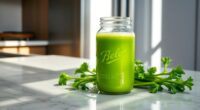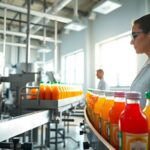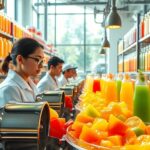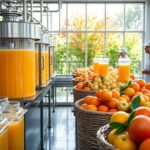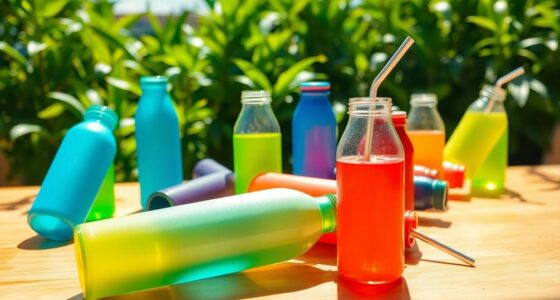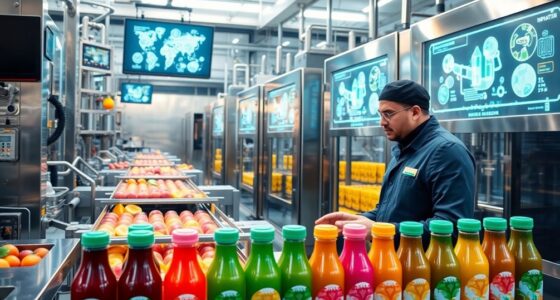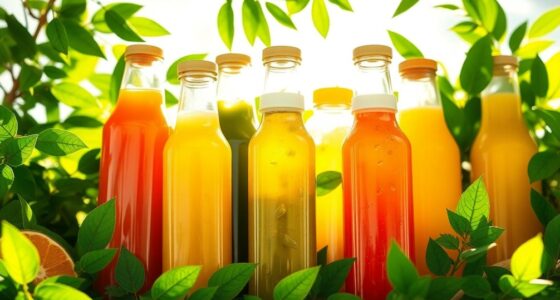To guarantee exceptional quality control in juice manufacturing, focus on monitoring key parameters like acidity and sugar levels. Regular testing prevents deviations from standards, safeguarding both safety and flavor. Implement stringent hygiene practices and proper equipment cleanings to eliminate microbial risks. Techniques like pasteurization and heat treatments enhance product safety. By maintaining high-quality raw materials and adhering to regulatory compliance, you can boost customer satisfaction and brand reputation. Discover more effective strategies for quality control in juice production.
Key Takeaways
- Regular monitoring of acidity and sugar levels ensures compliance with quality standards and enhances flavor and shelf life.
- Strict hygiene practices and personal cleanliness among workers prevent microbial contamination throughout the juice production process.
- Heat-pasteurization and high-pressure processing (HPP) eliminate harmful pathogens, safeguarding consumer health and product safety.
- Thorough inspection of raw materials and adherence to peak ripeness yield higher quality juices with optimal flavor and nutrition.
- Implementing a robust HACCP system systematically identifies and mitigates contamination risks, ensuring consistent product quality.
What Is Fruit Juice Quality Control?
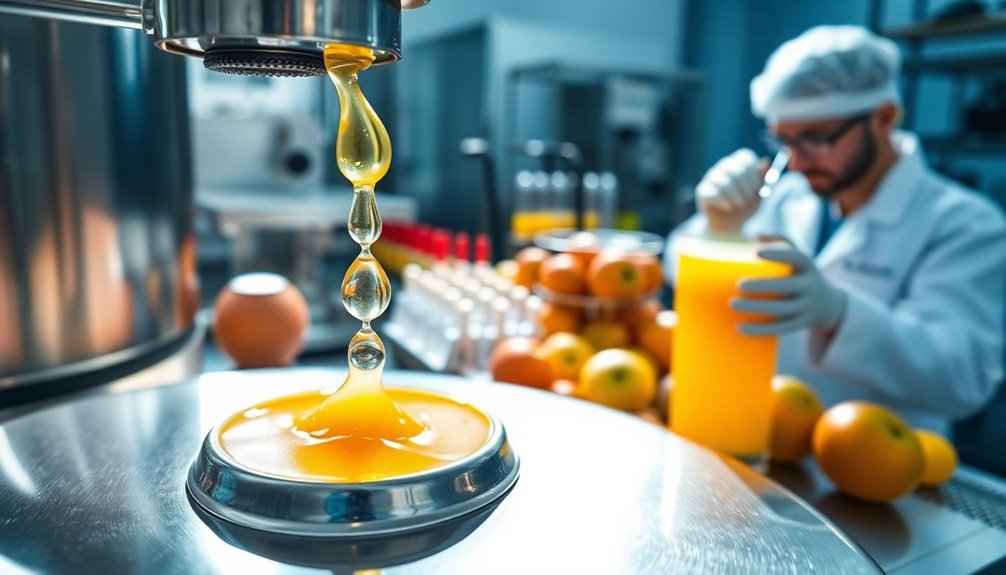
Quality control in juice manufacturing is fundamental for delivering a safe and consistent product. It involves systematic monitoring and regulation of the production process to guarantee the final juice meets quality standards. Quality control in juice production encompasses various stages, from raw material selection to the final packaging of the product. This process includes rigorous testing for microbial contamination, nutrient content, and flavor consistency to ensure consumer satisfaction. By implementing effective quality control measures, manufacturers can minimize waste, enhance product safety, and uphold their reputation in the competitive beverage market.
You'll implement quality control measures focusing on key parameters like acidity levels, sugar content, and microbial contamination, all essential for food safety. By adhering to regulatory requirements, like the Juice HACCP system, you help prevent foodborne illnesses linked to untreated juices.
Regular inspections and stringent hygiene practices are critical to minimize health risks and maintain product integrity. Ultimately, effective quality control enhances customer satisfaction, allowing you to identify deviations from standards and protect your brand's reputation in the competitive market.
Why Is Quality Control Important in Fruit Juice Production?
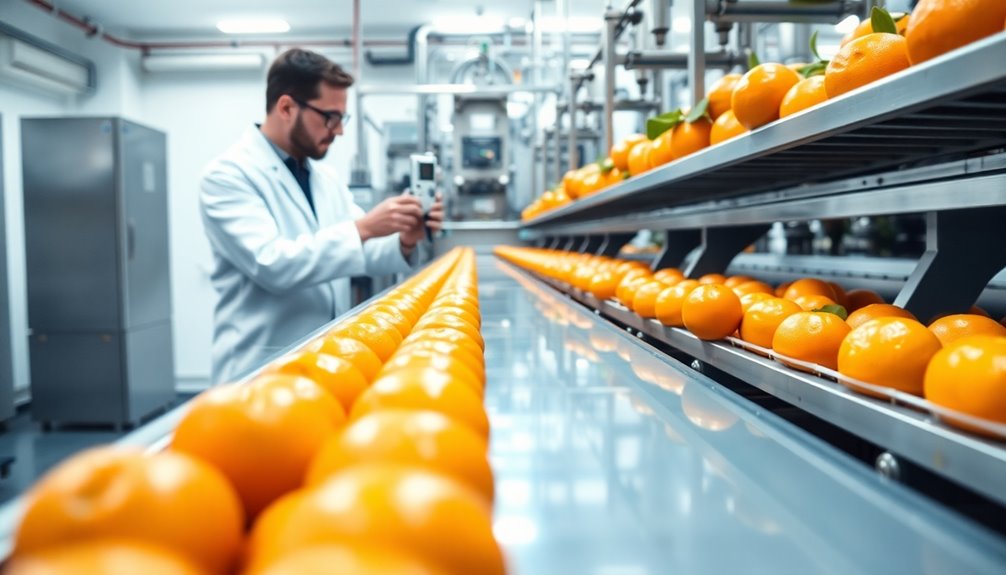
Guaranteeing the safety and consistency of fruit juice is essential for both producers and consumers alike. Quality control safeguards health by monitoring acidity, sugar levels, and microbial contamination, preventing unsafe products from reaching the market. By adhering to regulatory requirements and employing rigorous quality control protocols, juice manufacturers can maintain high safety and quality standards.
| Benefits of Quality Control | Impact on Juice Production |
|---|---|
| Enhances customer satisfaction | Consistent product quality |
| Builds brand reputation | Increases consumer preferences |
| Minimizes waste and recalls | Protects profitability |
Through effective quality assurance, you help guarantee that your juices meet consumer expectations, contributing to a trustworthy brand image and long-term success.
Parameters Monitored in Fruit Juice Production
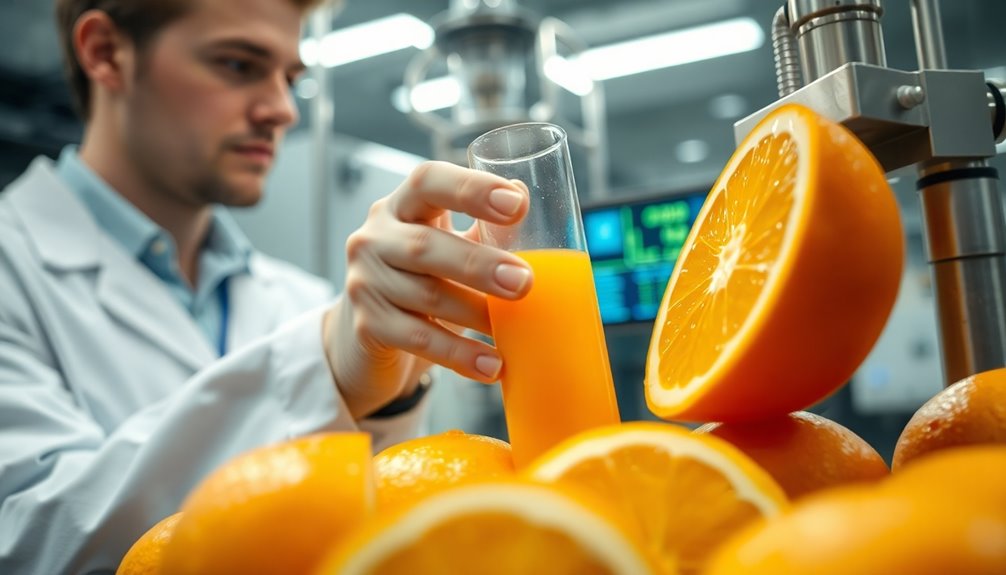
When you're producing fruit juice, monitoring acidity and sugar levels is essential for achieving the right flavor and quality.
You'll also need to conduct microbial contamination testing to guarantee the safety of your product.
Keeping a close eye on these parameters helps maintain high standards and meets consumer expectations.
Acidity and Sugar Levels
Acidity and sugar levels are vital parameters in fruit juice production, as they directly affect flavor and shelf life.
You'll find that acidity levels typically range between 3.0 and 4.0 pH, depending on the fruit type, essential for taste and preventing spoilage.
Monitoring sugar content, measured in Brix, helps meet consumer preferences and guarantees accurate labeling.
Regular testing for these levels is key to identifying deviations from quality standards, allowing for timely adjustments in the production process.
Both acidity and sugar content contribute considerably to the preservation of juice shelf life, influencing microbial stability and overall product safety.
Compliance with food safety regulations requires routine monitoring of these parameters to safeguard consumer health and maintain product quality. Furthermore, regular testing of acidity can help prevent spoilage and maintain the juice's integrity over time.
Microbial Contamination Testing
Microbial contamination testing plays a significant role in maintaining the safety and quality of fruit juices. In juice production, detecting harmful bacteria, yeast, and mold is essential for ensuring food safety.
Common sources of microbial contamination include raw fruits, processing equipment, and the environment, which is why rigorous sanitation protocols are necessary. You'll often use culturing methods to identify specific pathogens and their levels, ensuring compliance with food safety regulations.
The HACCP system requires regular monitoring of microbial levels throughout the production process. By implementing effective microbial testing, you can prevent foodborne illnesses, as past outbreaks linked to untreated juices underscore the importance of stringent quality control measures.
Your commitment to testing protects both consumers and your brand's reputation.
Methods of Quality Control in Juice Processing
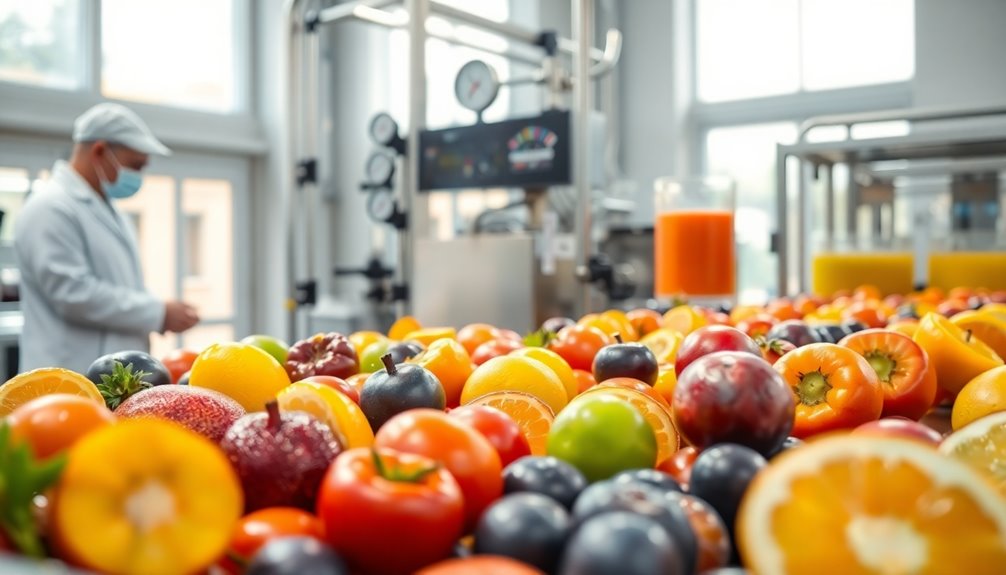
You know that maintaining the right pH levels is essential in juice processing, as it directly influences taste and shelf-life.
Additionally, preventing microbial contamination through diligent testing helps guarantee your product is safe and high-quality.
Ph Monitoring Techniques
Monitoring pH levels is vital in juice manufacturing to guarantee the final product meets quality standards. pH monitoring techniques, such as using pH meters, provide precise readings that allow for real-time adjustments, securing quality throughout the manufacturing process.
Keeping pH within the ideal range of 3.0 to 4.0 is essential for maintaining taste, color, and shelf-life. Regular testing prevents spoilage and helps you achieve consistent quality across batches, as deviations can negatively impact flavor and longevity.
Additionally, implementing these techniques not only enhances juice safety but also assures compliance with food safety regulations. By prioritizing pH monitoring, you can meet consumer expectations for high-quality juice products while safeguarding their health.
Microbial Contamination Prevention
While ensuring juice quality, preventing microbial contamination is essential in the manufacturing process. You need to adopt strict hygiene practices throughout production to mitigate risks from raw fruits, equipment, and the environment. Regular testing for harmful microbes and employing pasteurization and heat treatments are critical steps in ensuring food safety.
| Microbial Threat | Prevention Method |
|---|---|
| Bacteria | Pasteurization |
| Yeast | Regular Testing |
| Mold | Equipment Sanitization |
| Environmental Contaminants | Hygiene Protocols |
| Worker Contamination | Personal Hygiene |
Key Measures to Prevent Quality Loss in Juice Production
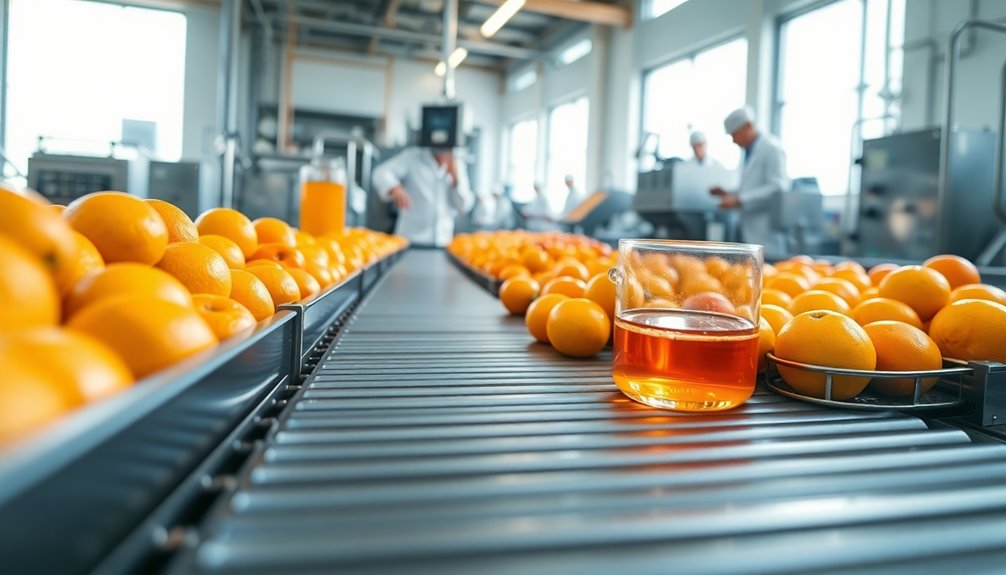
To guarantee high-quality juice production, implementing stringent hygiene and sanitation practices throughout the manufacturing process is essential.
Here are key measures to prevent quality loss:
- Regular Monitoring: Track pH levels, acidity, and sugar content to maintain consistent quality.
- Raw Material Inspection: Sort and inspect fruits for defects before processing to ascertain only high-quality produce is used.
- Heat Treatment: Utilize heat-pasteurization or high pressure processing (HPP) to eliminate harmful pathogens and extend shelf life.
- Regulatory Compliance: Adhere to HACCP guidelines to meet safety standards, minimizing contamination risk.
The Role of Hygiene in Juice Manufacturing
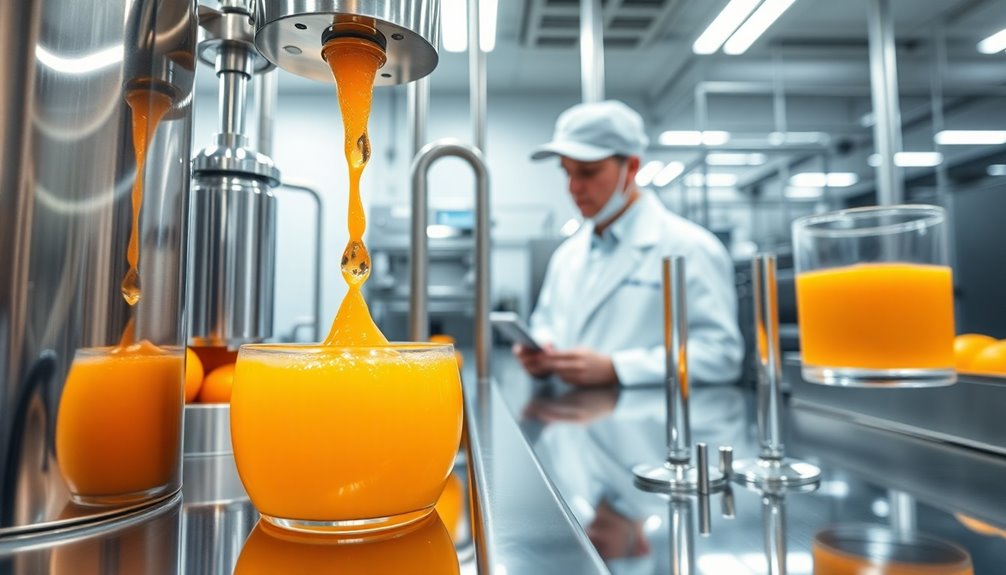
In juice manufacturing, maintaining hygiene is essential for producing safe and high-quality products.
You need to guarantee that equipment is regularly cleaned and that workers follow strict personal hygiene practices.
Importance of Clean Equipment
Clean equipment is essential in juice manufacturing, as it directly impacts the safety and quality of the final product.
Here are four key reasons why maintaining clean equipment is vital:
- Prevents microbial contamination – Keeping equipment clean minimizes the risk of harmful pathogens.
- Guarantees compliance – Adhering to food safety regulations is easier when hygiene protocols are strictly followed.
- Supports Juice HACCP – The Juice Hazard Analysis and Critical Control Points system relies on clean equipment to guarantee product safety.
- Extends shelf life – Proper cleaning methods preserve flavor and nutritional quality, giving your juice a longer shelf life.
Worker Personal Hygiene Practices
Maintaining a high standard of cleanliness in juice manufacturing goes beyond just the equipment; it extends to the workers as well.
Strict worker personal hygiene practices are fundamental in preventing microbial contamination. You need to follow proper handwashing protocols and wear clean uniforms, gloves, and hairnets to minimize the risk of transferring pathogens.
Regular training on employee hygiene practices guarantees compliance with food safety standards, protecting consumer health. It's important to verify that employees are free from illnesses that could contaminate the juice, so sick workers must stay out of the production area.
Personal hygiene audits and inspections are conducted regularly to enforce these standards and identify areas for improvement in worker sanitation practices. Your commitment to hygiene is essential for quality control. Additionally, understanding the importance of early screening methods can further enhance food safety strategies.
Sanitation Protocols and Standards
Hygiene plays a pivotal role in juice manufacturing, serving as a frontline defense against microbial contamination.
To maintain high-quality standards, you should focus on:
- Regular cleaning of equipment to prevent contamination.
- Thoroughly washing fruits to eliminate dirt, pesticides, and microorganisms.
- Enforcing personal hygiene among workers, including handwashing and clean uniforms.
- Implementing strict sanitation protocols to adhere to food safety regulations.
These practices considerably reduce health risks associated with raw materials.
Compliance with the Juice HACCP system ensures regular inspections, while continuous monitoring through quality control protocols helps maintain safety parameters.
Factors Affecting Juice Quality
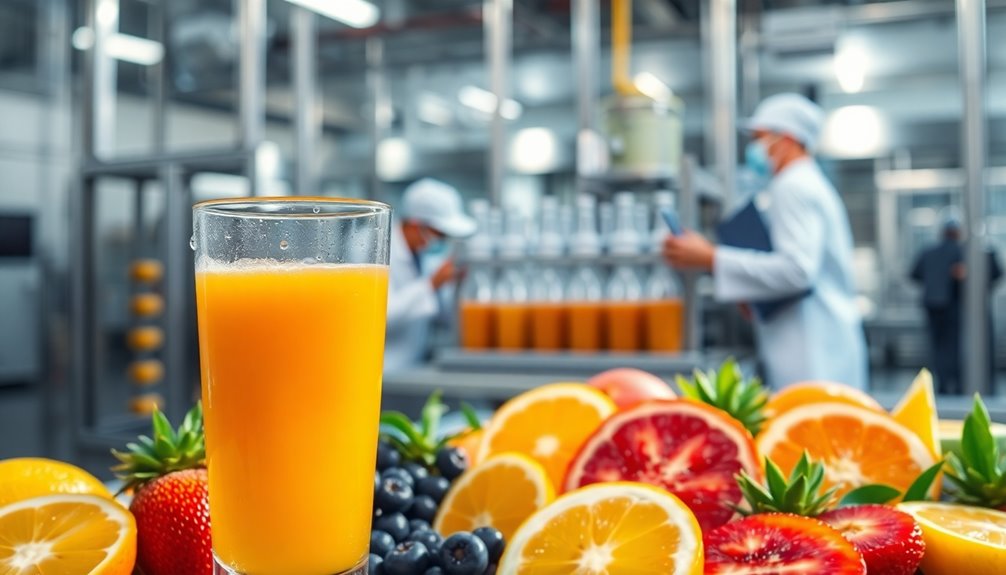
When it comes to juice quality, several key factors come into play, each influencing the final product's taste, appearance, and nutritional value.
The quality of the raw fruits and vegetables you select is essential; fresh, high-quality produce guarantees optimal flavor and nutrients. Harvesting fruits at the right ripeness stage is important for achieving the best results.
Additionally, common pollutants, including harmful bacteria, can compromise juice quality, making rigorous testing necessary throughout the production line.
Your production methods, like extraction and pasteurization, also considerably affect quality by preventing spoilage.
Finally, regular audits and inspections are critical for monitoring key parameters, such as acidity and sugar content, to maintain consistent juice quality and safety.
Addressing Microbial Concerns in Juice Production

To guarantee juice safety and quality, addressing microbial concerns is essential throughout the production process.
Here are four key strategies to combat microbial contamination in juice production:
- Regular Testing: Conduct stringent testing for harmful bacteria, yeast, and mold.
- HACCP System: Implement a robust HACCP system to monitor and control microbial risks.
- Heat Pasteurization: Use heat pasteurization to eliminate pathogenic microbes, ensuring food safety and extending shelf life.
- Hygiene Practices: Maintain strict cleaning and sanitization of equipment and enforce personal hygiene among workers.
The Impact of Harvest and Transportation on Juice Quality
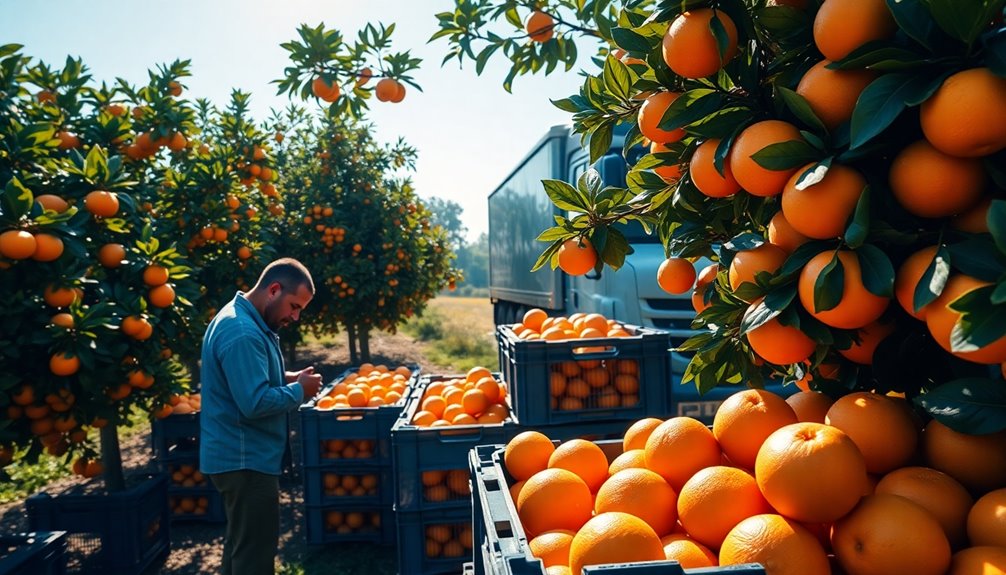
Microbial safety isn't the only factor influencing juice quality; the journey from orchard to processing facility plays a significant role as well. The timing of your harvest is essential—fruits picked at peak ripeness yield better flavor and nutrition. Additionally, rough handling during transportation can damage these fruits, leading to spoilage or contamination. To preserve juice quality, implement gentle handling techniques and guarantee proper storage conditions, like maintaining appropriate temperatures. Furthermore, conducting quality control tests on raw materials before production helps ensure that only the best fruits are used in the juice.
| Harvest Factors | Transportation Factors |
|---|---|
| Peak ripeness selection | Gentle handling techniques |
| High-quality fruits | Appropriate temperatures |
| Undamaged fruits | Timely delivery |
| ideal picking time | Clean transport vehicles |
| Minimal exposure to elements | Controlled humidity |
These practices directly impact the final product's quality.
Regulatory Compliance and Quality Assurance in Juice Manufacturing
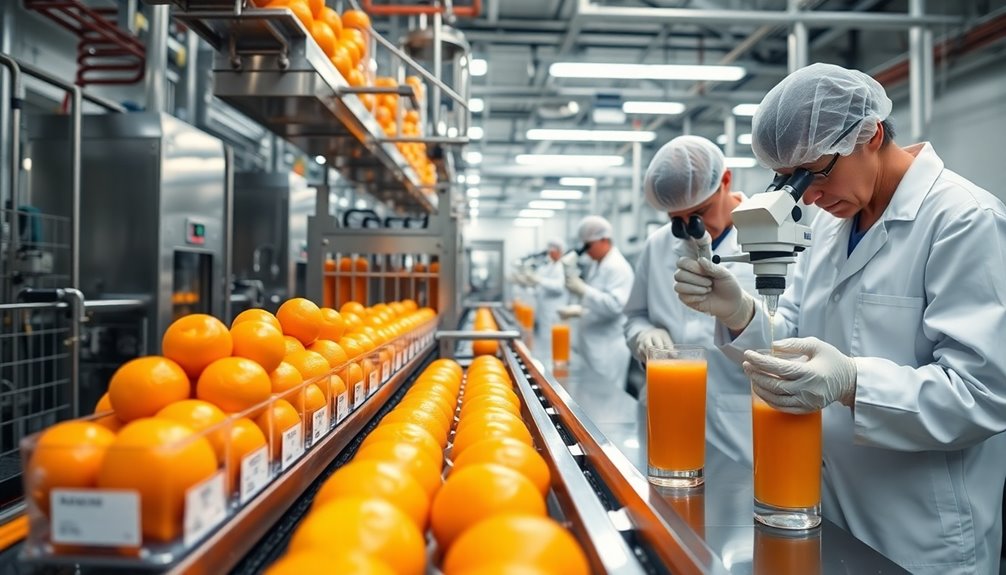
Ensuring regulatory compliance and quality assurance in juice manufacturing is essential for safeguarding consumer health and maintaining market trust.
Here are key elements to take into account:
- Implementing the HACCP system to identify and control food safety hazards.
- Adhering to the FDA Food Safety Modernization Act (FSMA) guidelines for preventive measures.
- Utilizing heat-pasteurization or high pressure processing (HPP) to eliminate harmful bacteria.
- Monitoring pesticide residues through the Pesticide Data Program (PDP) for safe levels.
Frequently Asked Questions
What Is First Quality in Quality Control?
First quality in quality control refers to producing items without defects during the initial run.
It's your goal to achieve a high First Time Quality (FTQ) percentage, which indicates efficiency and reduces waste.
By focusing on FTQ, you minimize rework and enhance customer satisfaction.
To boost your FTQ, you'll want to invest in employee training, implement strict quality measures, and foster a culture of continuous improvement throughout your organization.
What Are Two Steps You Take to Ensure Quality in Food Production Management?
In food production management, you can't overlook the basics while embracing advanced technologies.
First, you should implement regular inspections of raw materials to catch any defects before processing.
Then, adopt a systematic approach like HACCP to identify and control food safety risks throughout production.
What Are the Steps in Quality Control?
To guarantee quality control, you start with selecting and inspecting raw materials to meet standards.
Next, you monitor critical parameters like pH and sugar content throughout production.
Regular microbial testing helps you catch any harmful bacteria before it affects the product.
You also enforce strict sanitation practices and conduct systematic inspections to maintain hygiene.
What Are the Key Components of Quality Control?
To guarantee effective quality control, you need to focus on several key components.
Regularly monitor acidity levels, sugar content, and color consistency to maintain product standards.
Implement the HACCP system to identify and manage safety hazards.
Don't forget about sanitation; thorough cleaning and strict hygiene practices are essential to prevent contamination.
Finally, utilize advanced technology for process monitoring, allowing you to efficiently control production parameters and uphold consistent quality throughout your juice manufacturing process.
Conclusion
In the vibrant world of juice manufacturing, quality control isn't just a checklist; it's the lifeblood that transforms fresh, sun-kissed fruits into liquid gold. By vigilantly monitoring every step—from the orchard to your glass—you guarantee each sip bursts with flavor and freshness. Picture the radiant colors and tantalizing aromas that dance around you as you savor that perfect juice. With unwavering commitment to quality, you're not just making juice; you're crafting an experience that delights the senses.
Cindy thoroughly researches juicing trends, techniques, and recipes to provide readers with practical advice and inspiration. Her writing style is accessible, engaging, and designed to make complex concepts easy to understand. Cindy’s dedication to promoting the advantages of juicing shines through her work, empowering readers to make positive changes in their lives through the simple act of juicing.


